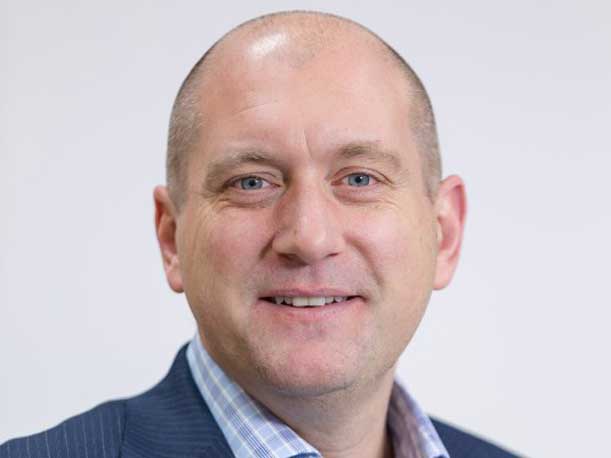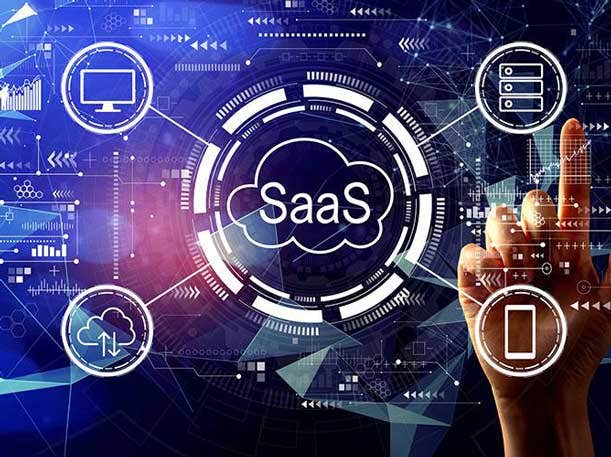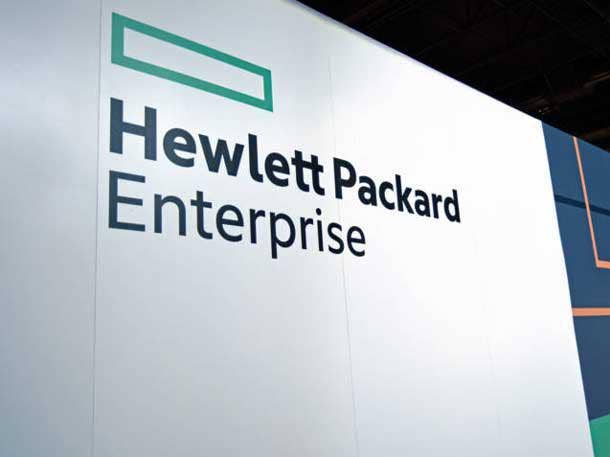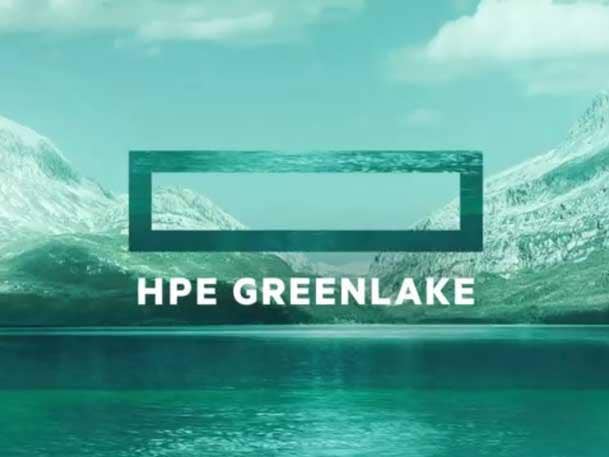HPE VP Simon Ewington On ‘Super Revolutionary’ GreenLake IaaS And SaaS Model And What Differentiates HPE From Dell
HPE Vice President of Worldwide Channel and Partner Ecosystem Simon Ewington says the hybrid cloud powerhouse’s shift to pay more on IaaS and SaaS GreenLake cloud services is a ‘super revolutionary’ step forward that sets HPE apart from rival Dell Technologies.

Building On The HPE ‘Head Start’ In As-A-Service Solutions
Hewlett Packard Enterprise Vice President of Worldwide Channels and Partner Ecosystem Simon Ewington said the shift to pay partners more for GreenLake IaaS and SaaS offers in the new Partner Ready Vantage program builds on the “head start” that HPE has over competitors like Dell Technologies in the as-a-service market.
“We are fortunate that we have had a CEO [Antonio Neri] with great insight into where the market is going,” said Ewington when asked to detail the differences between Dell and HPE when it comes to IaaS and SaaS offers and channel commitment. “We have had a head start. That head start has allowed us to move from very customized solutions that many of our competitors are entering the market with today to much more standardized platform-based offers, which is where we want the market to go.”
Ewington said the shift to IaaS and SaaS offers versus custom Flex capacity on-premises GreenLake deals that are more complex and time-consuming is going to allow partners to close deals faster, earn higher margins and ultimately build a sustainable, long-term business.
“It is more efficient for us but, more importantly, it is more efficient for our partners,” said Ewington. “They can drive so many more sales cycles much quicker, drive to conclusion much quicker and move time to revenue much quicker. I think just because of the maturity and the length of time we have been in the market we have an advantage over some of our competitors who still have much more custom-type solutions.”
As to the difference between HPE and Dell with regard to channel commitment, Ewington cited HPE’s decades of being a channel-centric company.
“We have built our company on and with our channel partners, and we continue to build our strategy based on our partners in the future,” he said. “I think predictability in this industry is one of the most important attributes a vendor can drive with their partner community, and what we’re doing here with Partner Ready Vantage is we are reinforcing that predictability globally with a single program across all of our as-a-service business with a structure that will remain in place for years to come.”
The new Partner Ready Vantage channel commitment includes a no-holds-barred drive to share HPE as-a-service “crown jewels” so partners can build margin-rich services businesses, said Ewington.
“When we refer to crown jewels, it is the access we give for our partners to HPE’s IP, HPE’s tools, HPE’s processes to enable them to be successful in driving that services business,” said Ewington. “These are not just words. We are following up with assets that we have invested millions [of dollars] in and we are making those available to our partner community because, as Antonio says, we genuinely view the partner community as an extension of our own sales force and we look at the partner community and give them access to the tools, the processes, the IP that our own sales force has access to.”
Ultimately, the new HPE Partner Ready Vantage model, which goes into effect Nov. 1, is the next step in HPE’s pioneering five-year GreenLake as-a-service cloud journey, said Ewington.
“We are enhancing the opportunity for partners to make accelerated margins by adding their own services around our as-a-service portfolio,” said Ewington. “I believe that with our partner community we are being pioneers in taking the as-a-service business on to the next level of maturity.”

Talk about the opportunity HPE is bringing to partners with Partner Ready Vantage.
This is about the massive opportunity we think we are creating for our partners, the opportunity to expand, to grow partner practices and also most importantly to deliver real value to their customers.
Just to sort of set the context up for the discussion, the way I think we view the last five years is we have been on a journey. … That is essentially to develop the hybrid cloud business in the channel with HPE GreenLake and to be pioneers, to be pioneers with our partners, pioneers together.
I think where we are now is we recognize that we can’t stand still because the industry is not standing still, and Partner Ready Vantage is that next step in that journey where we want to ensure the continued relevance of partners by helping them to deliver value-added services that they can wrap around our solutions.
So to be super attractive as a vendor—which is important to us—we want to make sure we are attractive to the partner community, but more importantly to help the partner community to build a long-term, sustainable and viable business … ultimately to have a much more profitable business for our partner community.
A big part of that evolution is our approach and the move towards more standardized IaaS/SaaS offers, which is one of the ways we are enhancing and changing the way we pay our partners and why are we doing that? Because it is critical that we allow partners to drive more sales campaigns, to be more efficient, to close deals faster with less resources and with higher margins. We have to shift away from custom as-a-service solutions which, given how fast we have already scaled with partners, we know is not really sustainable in the future.
If we want to continue driving the same level of growth that we have done with our partners [going into] the future we have to evolve and shift towards more standardized offers.
We’ll obviously talk about rebates. But for me rebates is like only one part of the picture. It is actually an increasingly smaller part of the picture. Competitive pricing and the ability to add partner-led, partner-delivered services are equally—I would say arguably—much, much more important.

What is the IaaS and SaaS difference between HPE and other vendors?
Most of the solutions we have sold in the past and we have built the as-a-service business on have been on Flex or custom [GreenLake deals]. And I think with different vendors in the market—certainly those who are entering the market much later than we have—they don’t typically have IaaS- and SaaS-based offers in the market, which is why this differential between paying on sell-out versus installation is important.
If they develop towards a more platform-based offering—as we are now—then obviously it becomes probably less relevant over time.
What is the difference between Dell and HPE when it comes to IaaS and SaaS offers and channel commitment?
We are fortunate that we have had a CEO [Antonio Neri] with great insight into where the market is going. We have had a head start. That head start has allowed us to move from very customized solutions that many of our competitors are entering the market with today to much more standardized platform-based offers, which is where we want the market to go. And the reason we want the market to go there is it is more efficient for us but, more importantly, it is more efficient for our partners. They can drive so many more sales cycles much quicker, drive to conclusion much quicker and move time to revenue much quicker. I think just because of the maturity and the length of time we have been in the market we have an advantage over some of our competitors who still have much more custom-type solutions.

What is the north star in terms of the percentage of deals you want to move from custom Flex capacity to IaaS and SaaS with the new compensation model?
I don’t think we can give a percentage, but over time we naturally want to move the majority of our business. Over time—and it is going to take time—because it is a business that we need to mature. But over time we want to move towards much more standardized offers and they need to be attractive enough, they need to be priced competitively enough, which we believe they are because it just makes everybody more efficient. It makes us more efficient, and it makes our partners more efficient.
If a partner is selling a capital expenditure compute SAN or server deal, how does that differ from Flex and IaaS or SaaS offers?
We have different rebate structures for our Capex business versus our Opex business, which I think most vendors do in the market already have today. Our rebates on both on our Capex and Opex business are very competitive.
We recognize that we still have a lot of room to grow. We have been very successful selling HPE GreenLake and our as-a-service business in the last five years, but my goodness there is an awful lot of green space out in the market for us to develop further, which is why when we look at things like new logo bonuses that we are looking to pay our partners, the reality is that the vast majority of our business today is still new customers transitioning to our as-a-service portfolio for the first time.
We have a lot of space to go after here, and we are super excited about the opportunity we give to our partners not only in terms of going after that space but being more attractive as a vendor by opening that services portfolio up. And that’s the crown jewels here: We are giving our partners the opportunity to make more margin on services as some of the hyperscalers have done in the past and to drive more high-velocity business in our as-a-service offering with IaaS and SaaS.

How important is it that partners get those crown jewels and move to the repeatable business?
There are two things that we talk about when we refer to the crown jewels. The first is many vendors because of the margin-rich nature of services like to hold those services to themselves, basically maximize the margin opportunity for the vendor. What we are doing, which is fundamentally different in the market, is opening up that margin opportunity to partners because we think we can be much more attractive as a vendor and to drive much more long-term sustainable growth and partnership with the partner community by giving them access to that services opportunity. And the services opportunity far, far outweighs the margin the partners make on back-end rebates. That is No. 1
The second thing we are doing when we refer to crown jewels is the access we give for our partners to HPE’s IP, HPE’s tools, HPE’s processes to enable them to be successful in driving that services business.
These are not just words. We are following up with assets that we have invested millions in and we are making those available to our partner community because, as Antonio says, we genuinely view the partner community as an extension of our own sales force and we look at the partner community and give them access to the tools, the processes, the IP that our own sales force has access to.
The twin aspect of this is opening up the ability for them to add their own services to our as-a-service solutions and then giving them the tools and the processes to be able to be successful is like a double benefit to partners.
The combination of those two things rather than just looking at the rebate structure of a vendor [is key].
I think we have a game-changer here, and I think the partner community generally understands that we are building something for the future, something for the long term, sustainability and attractiveness of us as a vendor, and making sure they are relevant and they are future-proofed in terms of driving the as-a-service business on behalf of HPE.

How does the new IaaS and SaaS emphasis change the conversation from a custom deal to a point-and-click-like cloud services experience?
If you think about what we are trying to do is we are essentially trying to productize the as-a-service business, and there are some really good examples of that. So if you look at backup and recovery as a service, that is a perfect example of what you described as being able to point, click, order and have that essentially pretty much immediately as a service. That is not a hybrid on-premises cloud solution. That is a true SaaS solution. So we’ve got lots of examples where we really want to drive a more efficient productized as-a-services business in the future. And I think the partner community understands that.
Is that shift from custom to IaaS and SaaS a revolutionary step forward for HPE?
It’s super revolutionary combined with allowing our partners to wrap their own very high-margin services around these solutions and build long-term, sustainable practices—the combination of those two things I think is a game-changer.
What’s the ultimate economic impact from the changes on partner profitability and financial health of the partners, and what does it say about HPE’s partner commitment?
We’re showing commitment on a few levels. Firstly, it is the accelerator impact of industry-leading rebate levels with the ability for partners to drive their own very rich margin services combined with the tools, the IP, the processes, the assets that we are providing to the partner community.
We need and want the partner community to be super successful–even more so than we have been in the past—in driving our as-a-service business. The partner community has done an amazing job of driving turbo growth across our as-a-service business in the last five years. This is the next step to allow us and allow them to drive a long-term, even more profitable, sustainable relevant business in the future.

What is your message to partners about the difference between the HPE channel model and commitment compared with the Dell channel model and commitment?
I think that we have decades of being a channel-centric company. We have built our company on and with our channel partners and we continue to build our strategy based on our partners in the future.
I think predictability in this industry is one of the most important attributes a vendor can drive with their partner community, and what we’re doing here with Partner Ready Vantage is we are reinforcing that predictability globally with a single program across all of our as-a-service business with a structure that will remain in place for years to come.
Plus, we are enhancing the opportunity for partners to make accelerated margins by adding their own services around our as-a-service portfolio. I believe that with our partner community we are being pioneers in taking the as-a-service business on to the next level of maturity.
Dell came out with a partner-led storage model paying sales reps more to go through the channel on storage. How will Partner Ready Vantage align with the HPE direct sales and partner rep model going forward?
I always think that we have to be very careful not to take the partner community for granted. I believe that we should fight for that channel preference, that partner preference as a vendor every single day. That is what we do.
We’re known for being partner-centric in the past, the present, and we will be known for being partner-centric in the future. But we do not take that for granted.

What is your message to partners with regard to the specific compensation changes?
So we are changing the structure of our as-a-service compensation, but as always, and you know us very well, we’ve made those changes and we designed those changes in collaboration with a lot of our partners.
So for a good example we tested some of the changes at our Partner Advisory Board and we have been rolling out testing the concept over the last couple of months with partners as well.
In essence, what we want to do in the future is we want to reward value and we want to recognize partners that are invested in our as-a-service business. ... These partners tend to be a little bit more self-sufficient.
Actually what we are doing is we are allowing partners to have the opportunity to earn more in the future, to earn up to 20 percent. And actually the bigger news is what we have talked about today.
With Partner Ready Vantage we are actually providing access to and giving partners the ability to deliver higher-margin services, which provides a much richer total opportunity for partners. It is not only about rebate—although we have got a very good story there—it is also about the ecosystem, the solution the partners can now build by using Partner Ready Vantage.

Where can partners make the most money and what do they need to do to align their business to be the most successful with HPE and drive the most profitable business, especially around GreenLake?
If we look at the sell track [of HPE Partner Ready Vantage], essentially there is still the same opportunity to earn from a rebate perspective and actually earn even more when we look at selling more standardized offers. But the bigger opportunity [for partners] here is wrapping their own services around [GreenLake], particularly around managed services. Because the margins that partners can make from selling and wrapping their own services around solutions are far in excess of what vendors typically pay in terms of rebates.
So is the aim with the shift to IaaS and SaaS to add to the partner base? And how aggressive will you be there?
We are trying to do two things: The first one is our partner business is built on our existing partners, and we have a lot of partners who are developing MSP-type capabilities. We really want to encourage those partners because that is what we have built our business on. But obviously with Partner Ready Vantage and particularly the managed services element, we are expecting to be much more attractive to CSPs [Cloud Service Providers] and MSPs and we would welcome the chance to work with those partners as well.
So are you going to go out and recruit a bunch of new MSP partners?
We are very, very open to working with new MSP and CSP partners.

Is there any analysis on the impact on net income and cash flow for the biggest partners that have done the custom GreenLake deals?
The type of partners you describe should have no concern with the changes we have made. It is exactly in line with the strategy.
How excited are you about the model moving forward here in terms of the economic impact and the opportunity for partners?
Super excited for two reasons: First, I think it will accelerate the focus on our as-a-service business because we are being so open about opening that margin opportunity for services to all of our partners. And that is where the big opportunity is, that is where the big margin is, that is where the enhanced levels of profitability are going to come from—it is from those services opportunities. That is something that I don’t believe our competition is doing to any degree. And I think that’s a game-changer for us. It’s a game-changer for our partners, and it’s a game-changer for how we develop and drive our hybrid cloud business in the future.